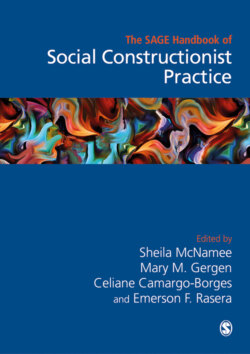Читать книгу The Sage Handbook of Social Constructionist Practice - Группа авторов - Страница 107
На сайте Литреса книга снята с продажи.
The First Round of Conversations
ОглавлениеOnce the place and time of the first conversation are set, it takes place without a script or guide, but the participants follow the path that emerges as the conversations flow. Harlene Anderson (2014) explains this very clearly in the following paragraph:
Participants in collaborative-dialogue are always on the way to learning and understanding and being careful to not assume or fill in the meaning and information gaps. In other words, participants mutually ‘inquire into’ something that has relevance for them. This learning, understanding, and carefulness require responsiveness in which a listener (who is also a speaker) is fully attentive and present for the other person and their utterances, whether expressed orally or otherwise. This also requires being aware of, showing acknowledgment of, and taking seriously what the other person has said and the importance of it. … This aim to learn and understand does not refer to asking questions to gather or verify information, facts, or data. Questions, as is any utterance, instead are posed as part of the conversational-dialogical process: to learn and understand as best one can what the other person is expressing and hopes will be heard. It is a responsive, interactive process rather than a passive one of surmising and knowing the other and their words based on pre-understanding such as a theory, hypothesis, or experience dialogical social beings as suggested by Bakhtin (1986), Buber (1970) and Wittgenstein (1953) and by Shotter's interpretations and extensions of Bakhtin's and Wittgenstein's perspectives. (p. 68)
Cynthia, reflecting on her conversations, says, ‘… the way it evolved, much more open, much more focused on seeing what will happen’, Carolina added ‘… other voices came in, and these voices invited other voices. Once, in the middle of a conversation, a third person came into the room, and then the co-researchers [people with whom I was having the conversation] raised the opportunity to invite them because they were talking of disability that is not normally spoken … it transformed the conversation into what ended up being, the story of three different families’. They went on to describe how the conversations that emerged were utterly different from what could have imagined at the beginning. Kenneth Gergen (2014) suggests that
the interview is a complex relational process and can unfold in ways that either invite or suppress the respondent's offerings. With the interviewer's keen sensitivity to the relationship and a continuing flexibility, respondents may supply far richer and more illuminating views than can ever be obtained through standardization. (p. 50)
Carolina comments on how she felt ‘a bit uneasy, a bit distressed because I was used to doing it in a more structured way.’ However, they described how, in general, the conversations were flowing, were very comfortable. It is important to mention that not all conversations took place in the same manner. Some were in person, others via different platforms, and other participants, like Christian, used blogs and social media.
